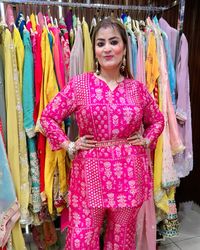Salman Khan’s Tiger 3 may be ambling along this World Cup season, but India has fully dedicated itself to a new sensation. Jasmeen Kaur, an Insta-find, is the new viral queen who has the entire nation mouthing her words. Her fans—those who have made memes on her “looking like a wow” video—include Deepika Padukone, Ranveer Singh, Allu Arjun, international model Ashley Graham, Nick Jonas, the Ministry of Railways and even someone’s pet cat. Last week, she was invited on Bigg Boss 17 to meet the contestants.
Kaur is a middle-aged shop owner who has been selling salwar kameez sets in Delhi’s not-so-posh Tilak Nagar for the last 18 years. Her aggressive hard-sell as well as her cuckoo mix of Hindi and English, paying no heed to syntax, have made her quite the entertainer. The ‘looking like a wow’ video features Kaur during an Instagram Live selling suit sets in an assortment of colours. She has a method to her linguistic madness. Colours are described in innovative ways: baingani purple (brinjal purple) or jamuni purple, ladoo yellow, ghiya green (gourd green), wine colour, pyaaz pink (onion pink), and of course the very famous muddy brown or “mouse colour”.
So why are Indian and international celebrities heralding a small shopkeeper peddling machine-made, cheap and kitsch, ethnic Indian clothing? Isn’t this everything that sustainability advocates advise against? Isn’t this the opposite of what small businesses stand for—artisanal, handmade wares? Yes, it is. And yet it is the story of Indian entrepreneurship. An entrepreneurship that comes in all shapes, sizes and definitions, and shores up a hero. Or in this case, a heroine.
Kaur has been running her shop for 18 years now. In an interview to Hindustan Times (she has been interviewed by a fleet of media by now, including the BBC), she says she is thrilled with the attention. “After a lot of hard work, my life has got such a boost,” she adds. For almost two decades, Kaur has been handling home as well as the boutique, she says. “I manage it somehow… My kids have been very supportive. My mother-in-law too; she handles the shop when I am late some days,” Kaur says.
Delhi’s Tilak Nagar is much like the pockets of India’s metros where Sikh, Punjabi and Sindhi refugees came to settle after the Partition. They came with just a little money on them, selling their homes and belongings for a song. They had to find a quick enterprise to make money. Salwar kameezes, saris and lehengas—all laden with elaborate embroidery on inexpensive China-made fabric—became the swift sell. Bazaars like Shankar Market and Chandni Chowk in Delhi, and Gandhi Market in Mumbai, are now go-to destinations when there is a wedding in the family.
Shops like Kaur’s have many stories to tell. Of the grit and the resourcefulness of India. Of its ingenious and entertaining ways of marketing. Of an open-hearted welcome. Of a humble, struggling India’s desire to dress up in shimmering finery, concealing her daily drudgery and dark spaces.
Even Sabyasachi Mukherjee, India’s most copied designer, says he is okay with our large and disorganised mass market as it puts food on a lot of tables.
Kaur is enjoying her time in the sun for now. She says she gets recognised on the street as “Wow-waali didi” or the “girl with the wow”. Her Instagram page (just shy of a million followers) shows off a paid promotion too, from a noodles brand. For now, she stands for a hustle with a heart of gold, matching the threads on her colourful suits.


